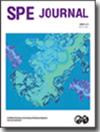预测天然气-重油/沥青系统密度的函数和体积转换策略的比较评估
IF 3.2
3区 工程技术
Q1 ENGINEERING, PETROLEUM
引用次数: 0
摘要
本研究提出了一个统一、一致且高效的框架,分别使用彭-罗宾逊状态方程(PR EOS)和索夫-雷德里希-邝(SRK)状态方程以及α函数和体积转换(VT)策略来更好地预测天然气-重油/沥青体系的密度。数据库包括 218 个实验测量的天然气-重油/沥青系统密度,选择并评估了在 0.70 的降低温度 (Tr) 下定义的五个 α 函数和在 Tr = 0.60 下定义的三个新 α 函数以及四种 VT 策略。对于 Tr = 0.70 时定义的 α 函数 1 至 4,VT 1 至 4 预测混合物密度的总体绝对平均相对偏差(AARD)分别为 7.21%、9.74%、7.02% 和 7.16%。对于 Tr = 0.70 时定义的 α 函数 5,这四种 VT 策略预测混合物密度的绝对平均相对偏差分别为 3.13%、5.01%、2.92% 和 2.56%。至于定义在 Tr = 0.60 时的两个新 α 函数 7 和 8,这四个 VT 策略预测的混合物密度的平均有害值分别为 1.38%、2.57%、1.34% 和 1.67%,其中 VT 3 预测的混合物密度与理想混合规则和有效密度(IM-E)预测的 1.31%的平均有害值非常接近。本文章由计算机程序翻译,如有差异,请以英文原文为准。
Comparative Evaluation of a Functions and Volume-Translation Strategies to Predict Densities for Gas(es)-Heavy Oil/Bitumen Systems
In this work, a unified, consistent, and efficient framework has been proposed to better predict the density of a gas(es)-heavy oil/bitumen system by using the Peng-Robinson equation of state (PR EOS) and Soave-Redlich-Kwong (SRK) EOS together with α functions and volume-translation (VT) strategies, respectively. With a database comprising 218 experimentally measured densities for gas(es)-heavy oil/bitumen systems, five α functions defined at a reduced temperature (Tr) of 0.70 as well as three new α functions at Tr = 0.60 together with four VT strategies are selected and evaluated. For α Functions 1 to 4 defined at Tr = 0.70, VTs 1 to 4 lead to an overall absolute average relative deviation (AARD) of 7.21%, 9.74%, 7.02%, and 7.16%, respectively, for predicting the mixture densities. For α Function 5 defined at Tr = 0.70, these four VT strategies predict the mixture density with an AARD of 3.13%, 5.01%, 2.92%, and 2.56%, respectively. As for the two new α Functions 7 and 8 defined at Tr = 0.60, these four VT strategies predict the mixture density with an AARD of 1.38%, 2.57%, 1.34%, and 1.67%, respectively, among which VT 3 has a very close prediction compared to an AARD of 1.31% obtained from the ideal mixing rule with effective density (IM-E).
求助全文
通过发布文献求助,成功后即可免费获取论文全文。
去求助
来源期刊

SPE Journal
工程技术-工程:石油
CiteScore
7.20
自引率
11.10%
发文量
229
审稿时长
4.5 months
期刊介绍:
Covers theories and emerging concepts spanning all aspects of engineering for oil and gas exploration and production, including reservoir characterization, multiphase flow, drilling dynamics, well architecture, gas well deliverability, numerical simulation, enhanced oil recovery, CO2 sequestration, and benchmarking and performance indicators.
 求助内容:
求助内容: 应助结果提醒方式:
应助结果提醒方式:


